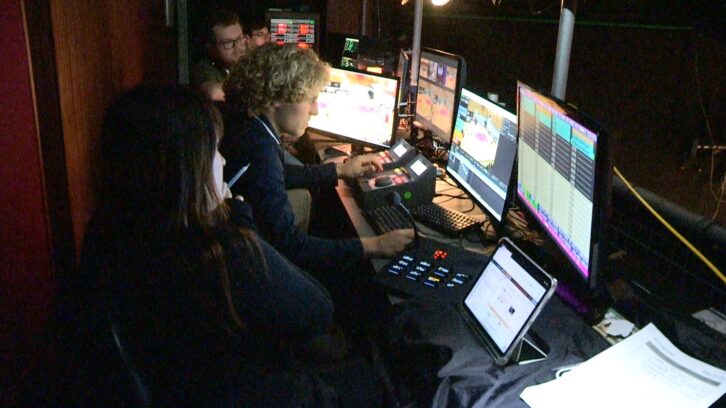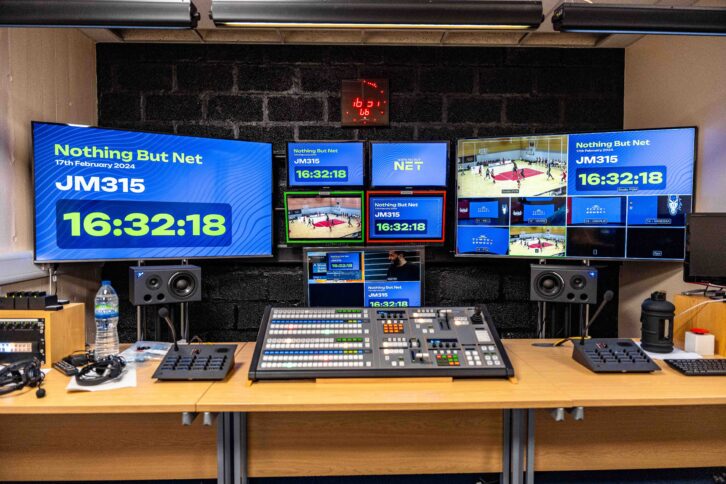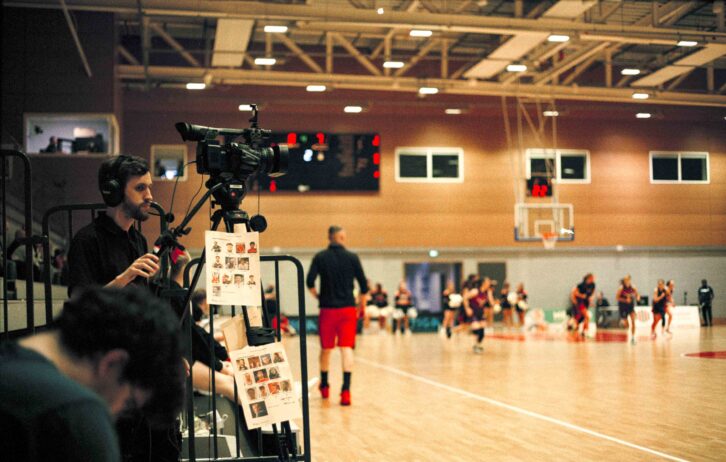Students at Solent University have successfully completed their final project, broadcasting a live basketball game to Basketball England’s YouTube channel.
A group of 50 students worked on the project, which combined their regular live basketball match coverage with studio presentation including the university’s brand-new LED virtual production wall.

The students produced five hours of live content covering both the men’s and women’s games and with the show including four feature VTs, studio presentation and analysis, courtside reporting and the match coverage. This was achieved with 15 cameras, 3 EVS operators, and live graphics.
“We had little to no technical hiccups and the production went smoothly which was a fantastic achievement for the whole team, we all left very proud!” director Ben Killackey tells TVBEurope.
The project surpassed their original expectations, says Killackey, “as we had access to amazing kit generously donated by the industry which really elevated our production values and the incredible teamwork of the crew working cohesively together.
“We effectively produced a five-hour unilateral sports broadcast and simultaneous multilateral feed, although the latter wasn’t distributed, just recorded for archive.”

However, the project wasn’t without some hiccups. The students had originally planned to use NDI to link their two galleries together, connected via the university network. They worked closely with the University tech team to identify suitable network ports and implement appropriate rules to allow the NDI traffic to traverse the network robustly. “However as we began more and more complex rehearsals as we neared transmission day, the University network struggled to keep up with NDI flows and we saw that the performance was hit significantly with high latency and lots of frame dropping,” explains Killackey.
“We suspect this was due to the very wide-ranging data rates and high burst allowed within the VBR techniques that are in the NDI standard. As well as the impact on picture quality this also meant our communications links (production talkback 4-wire, engineering 4-wire and presenter IFB’s etc) were also badly affected.”

The issue meant a very late night on Friday, as they tried to work out solutions. The team was aided by Andy Beale, who worked with them on the project, and the decision was taken to run fibre between the two galleries. “This meant an early start on Saturday morning, but thanks to an incredible team effort and industry support we managed to run two fibres (one main and one redundant) between the galleries which worked perfectly,” says Killackey. “These main signals went via a ‘Huinet’ SMPTE fibre system supplied by Timeline and the redundant route used fibre transceivers connected via Opticon.”
Killackey admits that with hindsight they would have considered planning for and setting up a redundant link earlier to mitigate the NDI connectivity risk. “Now understanding the implications of the very wide VBR in NDI we would also have stress-tested the link with more challenging and realistic content.

“However, considering that it was the first time we’d produced a show like this, I think we did really well on balancing the content in the show; including the length and placement of the different segments to really tell the story of the teams coming into the match and the games themselves!”
Killackey says the biggest challenge of the project was finding enough students to fill the 50 crew positions needed to make the project successful. “Thankfully there are so many passionate students at Solent we managed to ensure every role was covered – we even had a student from college in on work experience on the day.
“Linking the two galleries was a similarly big challenge – having spent months researching and setting up alongside the fantastic technicians at Solent, it was a little disheartening for it to all fail the night before but is still something we’re all proud that we managed to get working, just not on the scale required for this project.”

The team received lots of positive feedback from viewers watching the broadcast on YouTube. “Viewers were really impressed by the brand-new studio and match presentation and found the analysis segments extremely useful,” explains Killackey.
Asked what advice he’d give other students who were contemplating a similar project, he says it’s important to have belief in what you’re doing. “This was a huge project and one which had a limited timeframe, so we knew we had to keep pushing and continue to have belief in our idea. As a group, we tried to use the Christmas break as a time to be productive, with regular online meetings and planning sessions getting ready to come back and hit the ground running.”







